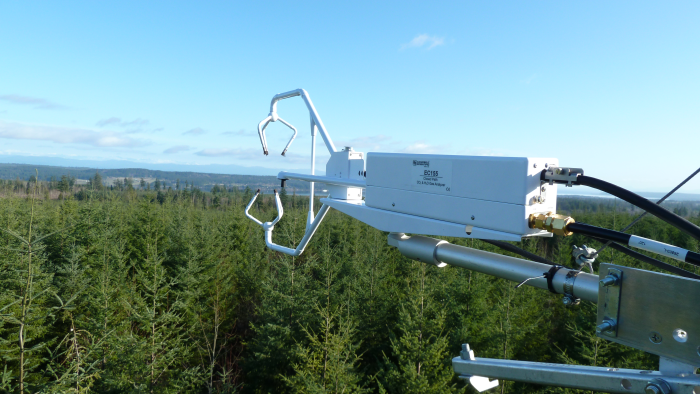



森林生息地は、他のどの陸上バイオームよりも炭素循環とプロセスに貢献しています。地球の陸上に貯蔵されている炭素の半分以上が、森林生態系の幹、枝、葉、根、土壌に貯蔵されていると考えられています。炭素吸収源としての重要性を考えると、科学界では、さまざまな森林生息地、および同様の特性を持ちながらも樹齢が異なる森林における総炭素隔離を理解し、定量化することがますます急務となっています。
2001 年、学界、カナダ政府機関、民間部門のパートナーシップにより、ブリティッシュ コロンビア州バンクーバー島のアイランド ティンバーランドにある 13 年物のダグラスモミ林に高さ 20 メートル (65 フィート) のフラックス タワーが設置されました。この設置は、ダグラスモミの伐採サイクル生産性に関する長期的クロノシーケンス研究の一環です。ブリティッシュ コロンビア大学の科学者は、2001 年以来、渦相関 (EC) 技術を使用して炭素隔離を継続的に監視しています。2002 年、この研究サイトは Fluxnet Canada の一部となり、2007 年にはカナダ炭素プログラムに含まれました。Fluxnet Canada 研究ネットワーク/カナダ炭素プログラムは、カナダの森林生態系の東西横断に沿った炭素循環を研究する大学および政府の科学者の全国的な研究ネットワークでした。
研究施設では、気候測定にCampbell Scientific CR23X データロガーが継続的に使用されています。ブリティッシュ コロンビア州西部などの湿潤な温帯森林環境に特に適したクローズド パス EC システムなど、EC フラックス測定技術が最近大きく進歩したことを受けて、この施設では補完的なプロジェクトが開始されました。2011 年に研究者らは、EC155 クローズド パス ガス分析装置と CSAT3A ソニック風速計を含むキャンベル サイエンティフィック CPEC200 クローズド パス EC システムを導入しました。CPEC200 は、完全に統合された低電力 EC システムとして設計されており、簡単に設置でき、長期にわたる測定安定性を提供し、自動化されたゼロおよび CO2スパンを備えています。
Campbell Scientific社の機器は、さまざまなセンサーから収集されたデータと、土壌、幹、枝のオートチャンバー測定から収集された CO2 フラックスの相互比較に貢献します。年間を通じて継続的に測定を行うことで、科学者は炭素隔離と水の使用が森林の樹齢と高さ、および肥料の散布などの人為的撹乱によってどのように変化するかを理解できるようになります。
このデータは、科学者がこれらの生息地の時間的および空間的な炭素循環をより深く理解するのに役立つ知識体系に貢献し、Fluxnet Canada Research Network を通じて広く利用可能になっています。
ケーススタディの概要
アプリケーション
森林地帯における炭素隔離の長期渦共分散評価場所
カナダ、ブリティッシュコロンビア州、バンクーバー島使用製品
CPEC200 CR23X EC155 CSAT3A CR3000寄稿者
Andy Black, principal investigator, and Zoran Nesic, research engineer; University of British Columbia参加団体
ブリティッシュコロンビア大学(UBC)生物気象学および土壌物理学グループ、バンクーバー島大学生物気象学研究所、カナダ自然科学・工学研究会議、カナダ森林局、ブリティッシュコロンビア州森林省、土地および天然資源管理、島嶼森林、アグリウム計測項目
CO 2と H 2 O の混合比、音速、3D 風速、土壌水分と温度プロファイル、相対湿度、光合成有効放射、純放射PDFで見る